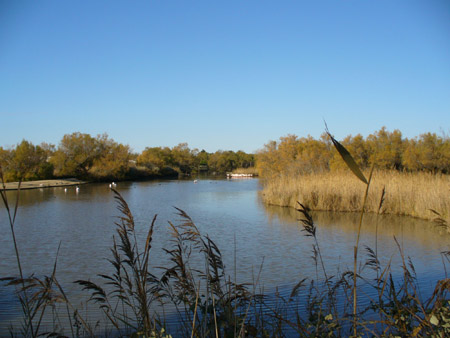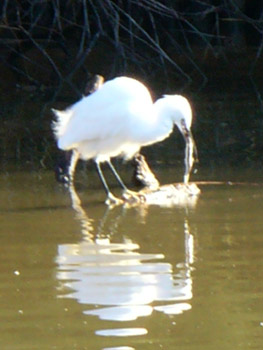 With an area of over 350 sq. miles, the Camargue is western Europe's largest river delta, bounded by the Rhone to the east, the Petit Rhone to the west and the Mediterranean Sea. It is a vast plain comprising large brine lagoons cut off from the sea by sandbars and encircled by reed-
covered marshes which are in turn surrounded by a large cultivated area, primarily for rice.
With an area of over 350 sq. miles, the Camargue is western Europe's largest river delta, bounded by the Rhone to the east, the Petit Rhone to the west and the Mediterranean Sea. It is a vast plain comprising large brine lagoons cut off from the sea by sandbars and encircled by reed-
covered marshes which are in turn surrounded by a large cultivated area, primarily for rice.
The Camargue is used for extraction of salt, agriculture, recreation and industry. In particular, the cultivation of rice and the extraction of salt have opposite requirements. The rice producers pump millions of cubic meters of freshwater into the Camargue, while the salt industry pumps millions of cubic meters of seawater into the delta.
 We awoke that morning with the reflection of the sunrise in the canal. From there we walked to a bus which took us for a tour of the area, the land of white horses, black bulls and more than 400 species of birds.
We awoke that morning with the reflection of the sunrise in the canal. From there we walked to a bus which took us for a tour of the area, the land of white horses, black bulls and more than 400 species of birds.
 The Camargue horse is the traditional mount of the Gardians, the French equivalent of cowboys, those ranch hands of the Camargue who are responsible for rounding up the wild black bulls that graze the land. Over time, the Gardians have developed the original breed of Camargue horses into a surprisingly agile, surefooted and reliable horse.
The Camargue horse is the traditional mount of the Gardians, the French equivalent of cowboys, those ranch hands of the Camargue who are responsible for rounding up the wild black bulls that graze the land. Over time, the Gardians have developed the original breed of Camargue horses into a surprisingly agile, surefooted and reliable horse.
 Some of the black bulls in a field.
Some of the black bulls in a field.
 Our next stop was at the Ornithological Reserve where most of the birds of Camargue, both resident and migratory, can be seen. The central area of the park has birds of prey, with many different owls, eagles, hawks, harriers, buzzards and vultures. Marsh birds and sea birds are here, with geese, swans, ducks, egrets, storks, herons and the pink flamingo, the icon of the Camargue.
Our next stop was at the Ornithological Reserve where most of the birds of Camargue, both resident and migratory, can be seen. The central area of the park has birds of prey, with many different owls, eagles, hawks, harriers, buzzards and vultures. Marsh birds and sea birds are here, with geese, swans, ducks, egrets, storks, herons and the pink flamingo, the icon of the Camargue.
 They have managed the ecology very well here to provide different kinds of habitat for the many birds which are here. From one lookout bridge, we could see on one side an area with reeds.
They have managed the ecology very well here to provide different kinds of habitat for the many birds which are here. From one lookout bridge, we could see on one side an area with reeds.
 From the same spot, in the other direction is an more natural original area which had been drained and salt water plants introduced to produce a different habitat for birds.
From the same spot, in the other direction is an more natural original area which had been drained and salt water plants introduced to produce a different habitat for birds.



Just three of the the many species of birds we saw on our walk. One of the birders in our tour said he was able to identify about 25 different species that morning.
 We saw large flocks of flamingos, the icon of the Camargue.
We saw large flocks of flamingos, the icon of the Camargue.

 A typical house in the area, the roof thatched with local reeds.
A typical house in the area, the roof thatched with local reeds.
From here we boarded our bus and drove to the seaside town of Saintes-Maries-de-la-Mer.
